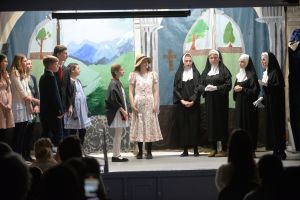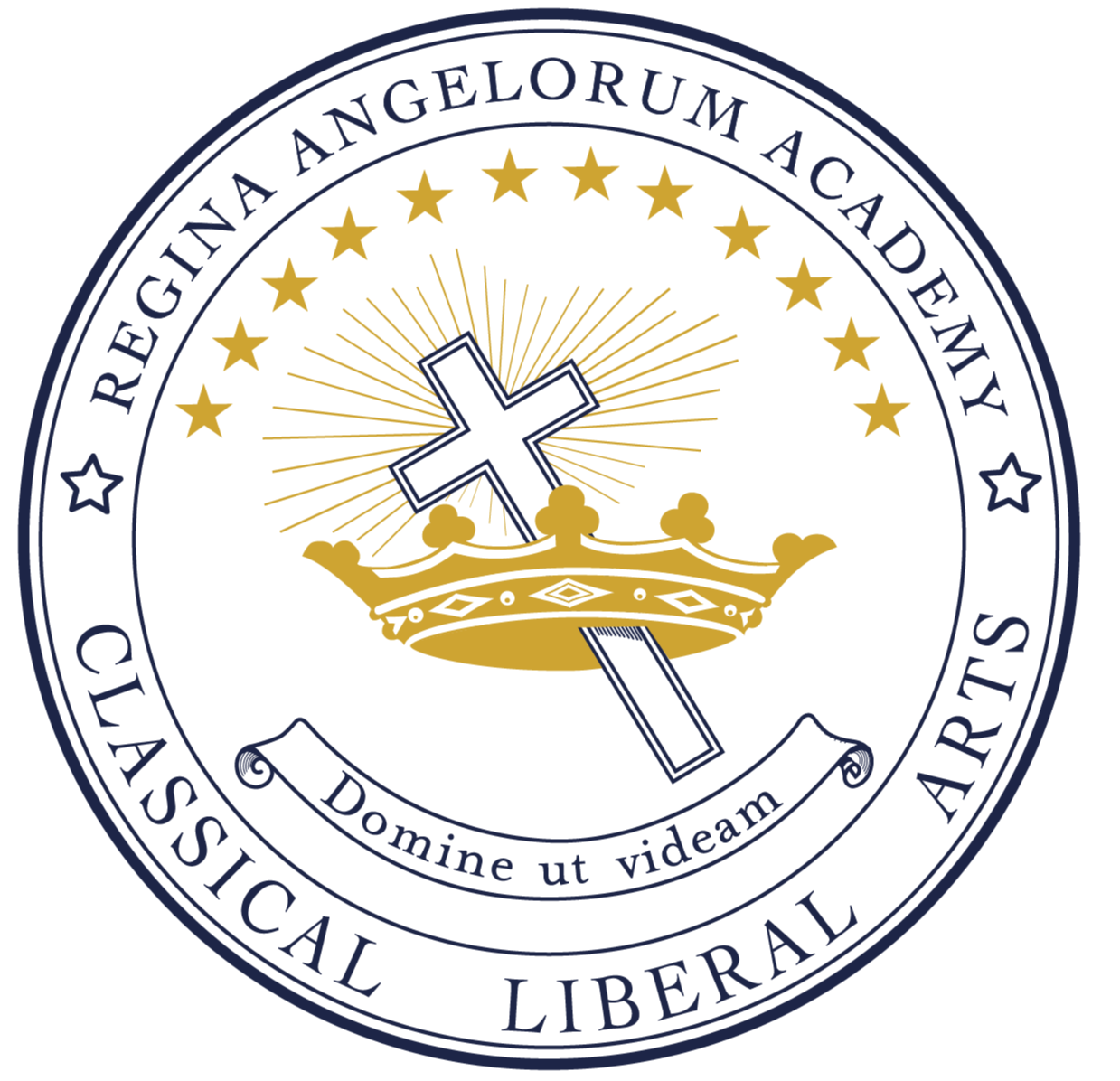Art: Overview and Examples
Art is the language of visual communication, and it helps us to develop a proficiency in visual expression.
The Visual Arts curriculum at Regina Angelorum Academy is designed to move students through a progression of exercises and experience that allow them to experiment, try new skills, and expand their understanding. They develop these art skills while seeing the harmony between the world that God has created and how it is shared through the visual arts in both sacred and secular subject matter.
Homeroom art classes reference material that aligns with the students’ studies in core subjects. Each grade works with a variety of genres and materials, using the elements of color, form, line, shape, space, texture, and value. As students gain experience with how these elements work together, they are encouraged to apply these principles using imitation, and other projects where they express their unique perspective and artistic point of view.
Whether art class is focused on a season or holiday, saints or historical figures, significant events or historical periods, or a religious event, sacrament, or holy day, children use mixed mediums and skills to further their development in the fine arts.
Examples across multiple grades include:
- Silhouettes of Mary and the unborn Christ Child at Christmas; Star of Bethlehem Wax Resist Watercolor Painting; Flight to Egypt Paintings; Three Kings Portraits
- President’s Day Portraits of Abraham Lincoln and Christopher Columbus
- Butterfly Lifecycle Collage; Birch Trees in the Snow Watercolor Painting
- Ancient Egyptian Tomb Painting, Pharoah Masks
- All Saints’ Procession Modeled after Trajan’s Column
- Still Life of Paten, Cross, and Chalice
- Coat of Arms; Castles and Dragons 3D Drawing
- Christopher Columbus Portraits
- Native American Still Life Pictures
- Self-Portraits
- Celtic Knot Design
- Venetian Carnival Masks
- Grandma Moses Landscapes
- Madonna and Christ portrait after Mary Cassatt
- Leonardo DaVinci’s Last Supper
Music: Overview and Examples
Musical training is a more potent instrument than any other, because rhythm and harmony find their way into the inward places of the soul, on which they mightily fasten, imparting grace, and making the soul of him who is rightly educated graceful, or of him who is ill-educated ungraceful; and also because he who has received this true education of the inner being will most shrewdly perceive omissions or faults in art and nature, and with a true taste, while he praises and rejoices over and receives into his soul the good, and becomes noble and good, he will justly blame and hate the bad, now in the days of his youth, even before he is able to know the reason why; and when reason comes he will recognize and salute the friend with whom his education has made him long familiar. – Plato – The Republic
Music programs are often some of the first to be eliminated from school curriculums. We believe that music education is fundamental to developing the whole person. Music is a unique language of human expression and points us, by way of beauty and emotion, to reason, and to God Himself. Regina Angelorum Academy’s focus on music aligns with the classical Quadrivium which includes music as one of the four core subjects. In the ancient world (along with arithmetic, astronomy, and geometry), music was a means to understanding how the world is ordered and how that order reflects the beauty and rational mind of the Creator. Students are introduced to music as a pathway enabling them to recognize beauty and what is also true and good.
In the earliest grades, the fundamental elements of rhythm, beat, and tempo are introduced through folk songs and masterworks from a variety of musical periods and styles. The Ward Method of Choral Singing is introduced to children to encourage them to develop their singing voice, understanding of sight-singing, and Gregorian chant. The essence of music is transcendent; something happens to a child’s soul when he or she is being formed through music at a young age.
As children grow into the elementary and middle school years, these fundamentals introduced in the early years, are integrated into the classical curriculum based on the era and world events students are studying. Composers and music from the Middle Ages through the Baroque and Classical periods are examples of both sacred and secular selections that are studied to bring the classical curriculum to fruition.
Favorite music in the early years:
Folksongs: The Erie Canal, Buffalo Gals
Hymns: O Holy Night, I Sing a Song of the Saints of God
Latin Chant: Hildegard von Bingen
Through teaching music as a language, children gain fluency in its expression, beauty, and a deep appreciation and understanding of its purpose in our world.
Drama: Overview and Examples
 Tests are one way to show what children know, but the dramatic arts are a powerful way to demonstrate understanding of the content of literature and history. Acting out a poem, scenes in Latin, or from a play, offer children the chance to use movement, elocution, and stage presence while interacting with others to demonstrate comprehension and enthusiasm for the subject content.
Tests are one way to show what children know, but the dramatic arts are a powerful way to demonstrate understanding of the content of literature and history. Acting out a poem, scenes in Latin, or from a play, offer children the chance to use movement, elocution, and stage presence while interacting with others to demonstrate comprehension and enthusiasm for the subject content.
Throughout a child’s day at Regina Angelorum Academy, the dramatic arts are intertwined through poetry recitation and public speaking, acting out literature or plays in groups, or preparing for the school’s annual Declamation presentation.
Each Spring, Regina Angelorum Academy presents a school play offering noble themes found in plays which have stood the test of time. Previous school play productions have included:
- The Lion, The Witch, and The Wardrobe
- The Wizard of Oz
- Anne of Green Gables
- The Wind in the Willows
- Don Quixote
